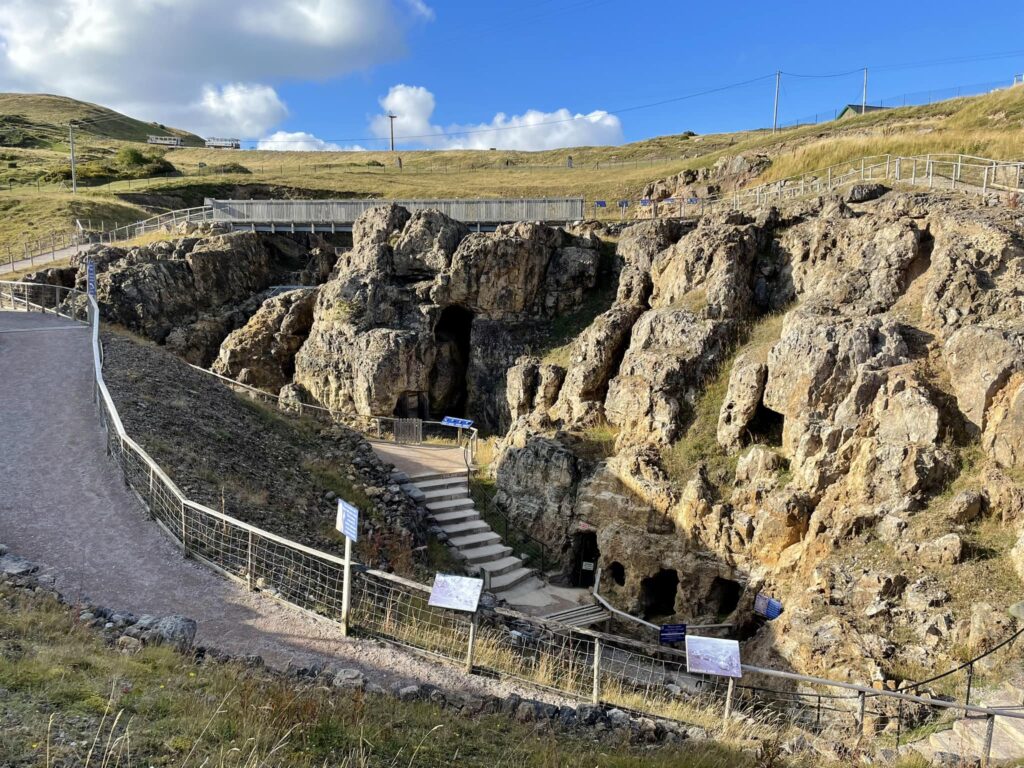Beneath the windswept hills of Great Orme in Wales lies one of humanity’s earliest and most remarkable industrial achievements. This 4,000-year-old copper mine, recognized as the largest prehistoric copper mine in the world, showcases the ingenuity, endurance, and societal organization of Bronze Age civilizations. Dubbed by one archaeologist as “the Stonehenge of copper mining,” the site offers not only an unparalleled glimpse into ancient mining techniques but also a deeper understanding of the social and economic fabric of prehistoric Europe.
The Discovery of a Hidden Labyrinth
In 1987, a landscaping project unexpectedly unearthed an intricate network of underground passageways. Beneath the surface lay a sprawling labyrinth of tunnels, passageways, and caverns that stretched over five miles, distributed across nine subterranean levels.
- Engineering Feats: These tunnels reach depths of 230 feet below ground and include passageways so narrow that they were likely carved by children. The use of stone tools such as hammers and chisels highlights the resourcefulness of the miners.
- Fire-setting Techniques: Evidence suggests the miners employed fire-setting, a technique involving heating rocks with fire and then rapidly cooling them with water to crack the stone. This method made it easier to extract copper ores embedded in the hard rock.

The Scale of Copper Production
The scale of the mine’s output is staggering. Experts estimate that the Great Orme mine produced enough copper to create 2,000 tons of bronze, a transformative material of the Bronze Age.
- Bronze and Its Importance: Bronze, an alloy of copper and tin, revolutionized tools, weapons, and trade. Its durability and versatility marked a significant technological leap over earlier stone tools.
- Regional and Global Impact: The abundance of copper from Great Orme likely fueled trade routes spanning across Europe. Artifacts made from Great Orme copper have been discovered far beyond Britain, underscoring its role in connecting early European societies.
The Role of Child Miners
One of the mine’s most striking discoveries is the evidence that children as young as five years old played a role in its operations.
- Labor Division: Narrow tunnels indicate that only small-bodied individuals—likely children—could navigate and work in such confined spaces. This raises questions about the societal roles and the harsh realities of prehistoric life.
- Tools and Techniques: These young miners likely wielded simple stone tools to extract copper ores, contributing to the mine’s extraordinary productivity.

Social and Economic Organization
The sheer scale and complexity of the Great Orme mine suggest the presence of a well-organized society.
- Specialization: The mining process would have required coordination among miners, tool makers, transporters, and smelters, indicating a division of labor.
- Trade Networks: The abundance of copper meant that Great Orme was likely a central hub in a network of trade routes. Communities across Europe would have sought this precious resource to fuel their own technological advancements.
Preservation and Public Engagement
Today, the Great Orme Copper Mine is a carefully preserved archaeological site and a popular tourist attraction. Visitors can explore its ancient passageways and learn about the people who worked there thousands of years ago.
- Educational Value: The site offers a unique opportunity to witness early mining technology and understand its importance to human history.
- Ongoing Research: Archaeologists continue to study the site, uncovering new insights into the lives of its prehistoric workers and the mine’s broader impact on the Bronze Age world.

Lessons from the Past
The Great Orme Copper Mine stands as a monument to human ingenuity and resilience. Its discovery reminds us of the profound impact natural resources have had on the development of societies throughout history.
- Sustainability: The Bronze Age’s dependence on finite resources like copper mirrors modern challenges with resource management. Understanding how past societies managed their resources provides valuable lessons for the future.
- Cultural Connection: Sites like Great Orme connect us to our ancestors, showcasing their achievements and reminding us of the enduring human spirit.
Conclusion
The Great Orme Copper Mine is more than an archaeological site; it is a window into the world of Bronze Age innovation, trade, and social structure. Its intricate tunnels, massive output, and evidence of community collaboration highlight the extraordinary capabilities of ancient civilizations. As we continue to study and preserve this treasure, it offers timeless lessons about resource use, technological advancement, and the power of human enterprise.
